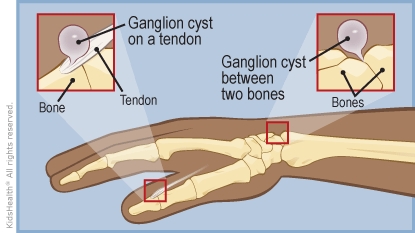A ganglion cyst is a fluid-filled swelling that forms on a tendon or in a joint. Most don't cause any problems, and many go away on their own within about a year. If a ganglion cyst causes your child pain or trouble with movement, your health care provider may recommend draining fluid from the cyst with a needle or surgery to remove it.



Your child has:

What causes ganglion cysts? The exact cause isn't known. Repeated movements may make a ganglion cyst swell, but doctors don't think this causes the cyst to develop.
What are the symptoms of a ganglion cyst? Some people might notice a bump where the ganglion cyst is. The bump may get a little bigger or smaller over time. A ganglion cyst can also cause pain or squeeze the nerve in the joint.
Can ganglion cysts come back? Ganglion cysts can come back. This is more likely to happen if it is drained or removed by surgery than if it goes away on its own.